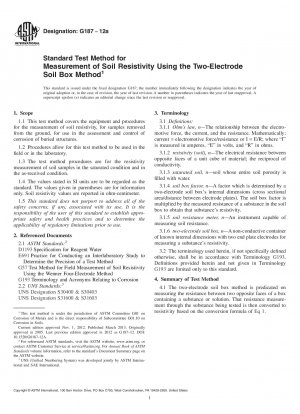ASTM G187-12a
Standard Test Method for Measurement of Soil Resistivity Using the Two-Electrode Soil Box Method
- Standard No.
- ASTM G187-12a
- Release Date
- 2012
- Published By
- American Society for Testing and Materials (ASTM)
- Status
- Replace By
- ASTM G187-18
- Latest
- ASTM G187-23
- Scope
5.1 The resistivity of the surrounding soil environment is a factor in the corrosion of underground structures. High resistivity soils are generally not as corrosive as low resistivity soils. The resistivity of the soil is one of many factors that influence the service life of a buried structure. Soil resistivity may affect the material selection and the location of a structure.5
5.2 Soil resistivity is of particular importance and interest in the corrosion process because it is basic in the analysis of corrosion problems and the design of corrective measures.
5.3 The test method is focused to provide an accurate, expeditious measurement of soil resistivity to assist in the determination of a soil’s corrosive nature. Test Method G57 emphasizes an in situ measurement commonly utilized in the design of a buried structures’ corrosion control (cathodic protection systems’ ground bed design, and so forth). The two-electrode soil box method often compliments the four-pin, in situ soil resistivity method.
5.4 The saturated soil resistivity determined by this test method does not necessarily indicate the minimum soil resistivity.
1.1 This test method covers the equipment and procedures for the measurement of soil resistivity, for samples removed from the ground, for use in the assessment and control of corrosion of buried structures.
1.3 The test method procedures are for the resistivity measurement of soil samples in the saturated condition and in the as-received condition.
ASTM G187-12a Referenced Document
- ASTM D1193 Standard Specification for Reagent Water
- ASTM E691 Standard Practice for Conducting an Interlaboratory Study to Determine the Precision of a Test Method
- ASTM G193 Standard Terminology and Acronyms Relating to Corrosion
- ASTM G57 Standard Test Method for Field Measurement of Soil Resistivity Using the Wenner Four-Electrode Method
ASTM G187-12a history
- 2023 ASTM G187-23 Standard Test Method for Measurement of Soil Resistivity Using the Two-Electrode Soil Box Method
- 2018 ASTM G187-18 Standard Test Method for Measurement of Soil Resistivity Using the Two-Electrode Soil Box Method
- 2012 ASTM G187-12a Standard Test Method for Measurement of Soil Resistivity Using the Two-Electrode Soil Box Method
- 2012 ASTM G187-12 Standard Test Method for Measurement of Soil Resistivity Using the Two-Electrode Soil Box Method
- 2005 ASTM G187-05 Standard Test Method for Measurement of Soil Resistivity Using the Two-Electrode Soil Box Method
